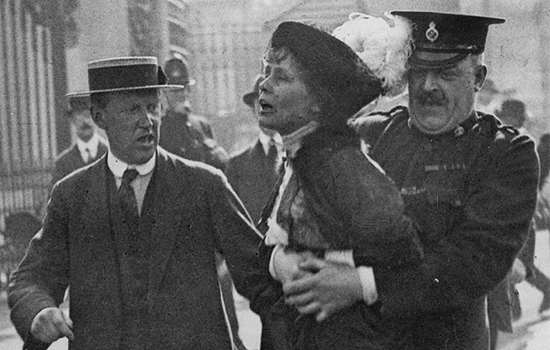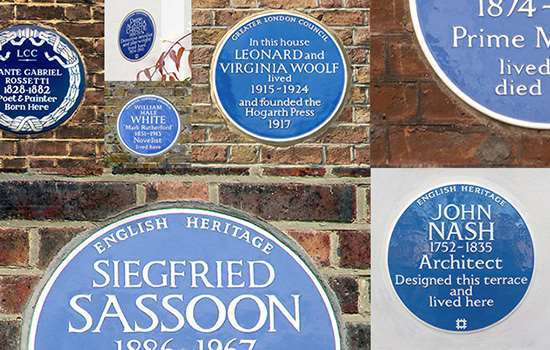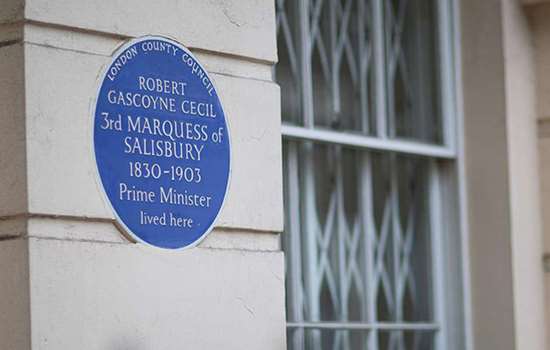LINNELL, John (1792-1882) and SILVY, Camille (1834-1910)
Plaque erected in 2019 by English Heritage at 38 Porchester Terrace, Bayswater, London, W2 3TP, City of Westminster
All images © English Heritage
Profession
Painter, Photographer
Category
Applied Arts, Fine Arts
Inscription
The house and studio of JOHN LINNELL 1792-1882 Painter later occupied by CAMILLE SILVY 1834-1910 Photographer
Material
Ceramic
The painter John Linnell and photographer Camille Silvy are commemorated with a blue plaque at 38 Porchester Terrace in Bayswater. Linnell lived and worked in the house from 1830 until 1851, while Silvy set up his studio and home there from 1859 until 1868.
JOHN LINNELL
Born in London, John Linnell was a landscape artist, portrait painter, and engraver. He was admired by John Ruskin and in the early nineteenth century was considered a rival to John Constable. Linnell was later overshadowed by his protegé and future son-in-law Samuel Palmer, but his naturalistic working landscapes, such as Kensington Gravel Pits, are now celebrated for their minutely observed detail of a world in transformation.
Number 38 Porchester Terrace was built for Linnell in 1829–30. Notoriously careful with money, Linnell insisted on doing much of the design and build himself. Accounts suggest that the painter pitched in with the building work on site and payed disgruntled workmen with paintings. Linnell moved into the 12-roomed villa with his family in 1830 and in 1836 built a further studio next door, which is now 36 Porchester Terrace. He moved out of Porchester Terrace in 1851 and variously leased out either both or one of buildings.
Linnell shares another plaque with his friend William Blake in Hampstead. Individuals are not usually granted more than one plaque, but an exception was made in Linnell’s case since a plaque had already been approved for his tenant, Camille Silvy.
CAMILLE SILVY
The Frenchman Camille Silvy moved to London in the summer of 1859 to take over the renowned photography studio Caldesi & Montechhi, based at Linnell’s house at Porchester Terrace. Silvy had studied photography in France and by this time had already produced his most famous work – River Scene, France (also known as Vallee de l’Huisne) – an artistic masterpiece that was exhibited in Edinburgh and London in 1858 and in Paris in 1859.
While at number 38 Silvy became one of the most successful and fashionable portrait photographers of his day. He mastered the new form of carte-de-visite – photographs pasted onto small pieces of card. Donning fresh white gloves for each sitting, Silvy photographed his clients in the opulent Porchester Terrace studios, and took equestrian portraits at the back of the premises. The house also encompassed a factory employing 40 people. As one 1862 article observed:
Walking through the different rooms, you are puzzled to know whether you are in a studio, or a house of business … his studio is at the same time a counting house, a laboratory and a printing establishment.
Silvy was dogged by illnesses that frequently kept him from his studio, and he retired from business in 1868. He believed that the chemicals he used in the darkroom had damaged his health, and he was also troubled by London’s coal-polluted air.
He returned to France in 1870 and later the same year was appointed Chevalier de la Legion d’Honneur for saving the lives of two companies of fellow soldiers during the Franco-Prussian war. However he subsequently suffered from a form of depression that has been likened to bipolar disorder or post-traumatic stress disorder, and from 1876 he spent his life in hospitals and nursing homes. Silvy died from bronchopneumonia in 1910 in the Hôpital de St Maurice, Charenton, aged 76, and is buried in Père Lachaise Cemetery, Paris.
Nearby Blue Plaques
More About Blue Plaques



